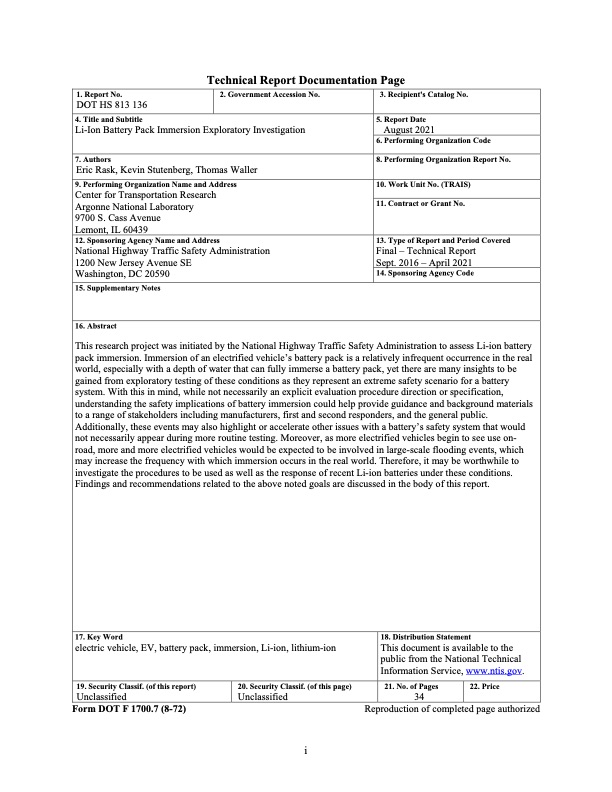
PDF Publication Title:
Text from PDF Page: 003
1. Report No. 2. Government Accession No. DOT HS 813 136 4. Title and Subtitle Li-Ion Battery Pack Immersion Exploratory Investigation 7. Authors Eric Rask, Kevin Stutenberg, Thomas Waller 9. Performing Organization Name and Address Center for Transportation Research Argonne National Laboratory 9700 S. Cass Avenue Lemont, IL 60439 12. Sponsoring Agency Name and Address National Highway Traffic Safety Administration 1200 New Jersey Avenue SE Washington, DC 20590 3. Recipient's Catalog No. 5. Report Date August 2021 6. Performing Organization Code 8. Performing Organization Report No. 10. Work Unit No. (TRAIS) 11. Contract or Grant No. 13. Type of Report and Period Covered Final – Technical Report Sept. 2016 – April 2021 14. Sponsoring Agency Code Technical Report Documentation Page 15. Supplementary Notes 16. Abstract This research project was initiated by the National Highway Traffic Safety Administration to assess Li-ion battery pack immersion. Immersion of an electrified vehicle’s battery pack is a relatively infrequent occurrence in the real world, especially with a depth of water that can fully immerse a battery pack, yet there are many insights to be gained from exploratory testing of these conditions as they represent an extreme safety scenario for a battery system. With this in mind, while not necessarily an explicit evaluation procedure direction or specification, understanding the safety implications of battery immersion could help provide guidance and background materials to a range of stakeholders including manufacturers, first and second responders, and the general public. Additionally, these events may also highlight or accelerate other issues with a battery’s safety system that would not necessarily appear during more routine testing. Moreover, as more electrified vehicles begin to see use on- road, more and more electrified vehicles would be expected to be involved in large-scale flooding events, which may increase the frequency with which immersion occurs in the real world. Therefore, it may be worthwhile to investigate the procedures to be used as well as the response of recent Li-ion batteries under these conditions. Findings and recommendations related to the above noted goals are discussed in the body of this report. 17. Key Word electric vehicle, EV, battery pack, immersion, Li-ion, lithium-ion 18. Distribution Statement This document is available to the public from the National Technical Information Service, www.ntis.gov. 19. Security Classif. (of this report) Unclassified Form DOT F 1700.7 (8-72) 20. Security Classif. (of this page) Unclassified 21. No. of Pages 22. Price 34 Reproduction of completed page authorized iPDF Image | Li-Ion Battery Pack Immersion Exploratory Investigation

PDF Search Title:
Li-Ion Battery Pack Immersion Exploratory InvestigationOriginal File Name Searched:
dot_57013_DS1.pdfDIY PDF Search: Google It | Yahoo | Bing
Product and Development Focus for Salgenx
Redox Flow Battery Technology: With the advent of the new USA tax credits for producing and selling batteries ($35/kW) we are focussing on a simple flow battery using shipping containers as the modular electrolyte storage units with tax credits up to $140,000 per system. Our main focus is on the salt battery. This battery can be used for both thermal and electrical storage applications. We call it the Cogeneration Battery or Cogen Battery. One project is converting salt (brine) based water conditioners to simultaneously produce power. In addition, there are many opportunities to extract Lithium from brine (salt lakes, groundwater, and producer water).Salt water or brine are huge sources for lithium. Most of the worlds lithium is acquired from a brine source. It's even in seawater in a low concentration. Brine is also a byproduct of huge powerplants, which can now use that as an electrolyte and a huge flow battery (which allows storage at the source).We welcome any business and equipment inquiries, as well as licensing our flow battery manufacturing.| CONTACT TEL: 608-238-6001 Email: greg@salgenx.com | RSS | AMP |